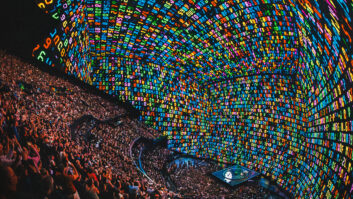
For those who have been around the AV industry for a while, few developments have been more exciting than those we’ve seen in screens – but the displays industry is far from finished with making its products better, as Ian McMurray finds out.
Here’s an interesting question. How many displays are there in the world? Think carefully. We’re not just talking about digital signage screens. (Depending on who you believe, that’s probably more than 20 million). We’re not just talking about TVs. Or PC monitors. Think harder… What about phones? Sat-navs? Car dashboards? That’s right: there’s a very large number. To put it in perspective: someone once calculated that, at 4,585,320,000,000,000, there are more pixels in the world than there are stars in the Milky Way (which is 100 billion – or maybe 400 billion).
The first question, then, in looking at where the displays industry is going, is whether there will be more pixels? After all: the most visible [sic] development in displays, other than them being flatter and thinner, has been the number of pixels per screen. From the paltry 307,200 of VGA resolution what seems like only a few years ago, we now take 8.8 million for granted. Do we need the 33 million pixels of the 8K resolution in which the Tokyo Olympics in 2020 will be captured/transmitted?
Perhaps remarkably, when talking about the direction in which the displays industry is heading, few see more pixels as being significant – at least in the near term.
“I don’t think there’ll be a major improvement in resolution in the near future,” says Max Winck, marketing manager at eyevis, “as there are still some issues that need to catch up with 4K – mainly content.”
Industry standard
Commentators expect that 4K will become the industry standard over the next few years. It’s easy to overlook the fact that not only has the higher resolution enabled improved image quality at today’s screen sizes, it has also allowed the development of larger formats in which pixellation is almost invisible at normal viewing distances – creating new installation opportunities.
“Corporate and education markets are expected to lead the adoption of 4K,” notes Thomas Issa, product manager at Sony Professional, “due to the rising demand for large screen sizes.”
The law of diminishing returns starts to come into play, however: 8K and higher resolutions may enable the development of even larger screens – but would they be practicable to install? At those image sizes, projection is invariably a very realistic alternative.
The subject of pixels is not entirely overlooked, however. One of the more interesting phenomena in the displays industry in the last year or so is the challenge that LED panels, with their innate advantages in power consumption, durability and flexibility, are mounting. The coarseness of their pixel pitch was irrelevant for bright images viewed from a distance – but precluded LED screens from consideration for indoor, close-up installations. That’s changing rapidly.
“LED technology is at an exciting turning point in the industry,” believes Steve Scorse, vice president, EMEA at SiliconCore. “At this year’s ISE, we saw across the board that manufacturers were bringing increasingly small pixel pitches to the show, with several sub-1mm pixel pitch displays showcased, including our Camellia 0.95mm LED display. These ultra-fine LED displays allow the clarity of image usually associated with an LCD display to be used with the flexibility of LED.
“At the same time, costs for manufacture have also fallen dramatically and this has led to a frenetic development of Direct View LED,” he continues, “which will likely see pixel pitch of 0.6mm in 2017 and sub-0.2mm before the end of the decade.”
According to Scorse, Direct View LED already has the highest contrast ratio of any display technology, and once HDR is fully implemented in a Direct View LED display, it has the potential to surpass every other display technology for image quality. Passive 3D, very low power, high brightness and high reliability should be deliverable in this time period too, he believes, and that will open up a massive range of display opportunities.
“The reduction of LED pixel pitches allows indoor use of LED modules for the first time,” notes Thomas Walter, section manager, strategic product marketing at NEC Display Solutions Europe. “Fine pitch LED has become a vital part of our display portfolio.”
Will LED sweep all before it? Winck is not convinced. “For videowalls, LED can displace LCDs to a certain extent,” he considers. “For individual display applications, though – probably not. Handling is more delicate; fine pixel pitch LEDs are very sensitive to mechanical manipulation. Touch displays will also not be too easy to implement with LED tiles. There are still many applications where LCD will remain the leading technology.”
www.eyevis.com
www.nec-display-solutions.com
www.pro.sony.eu
www.siliconcore.com







